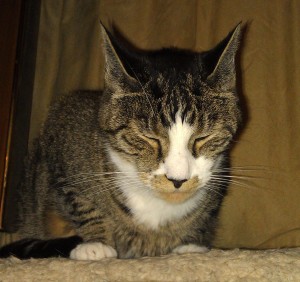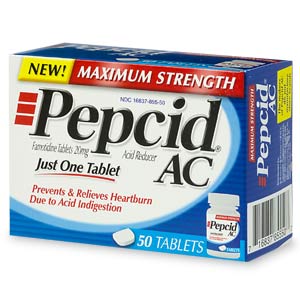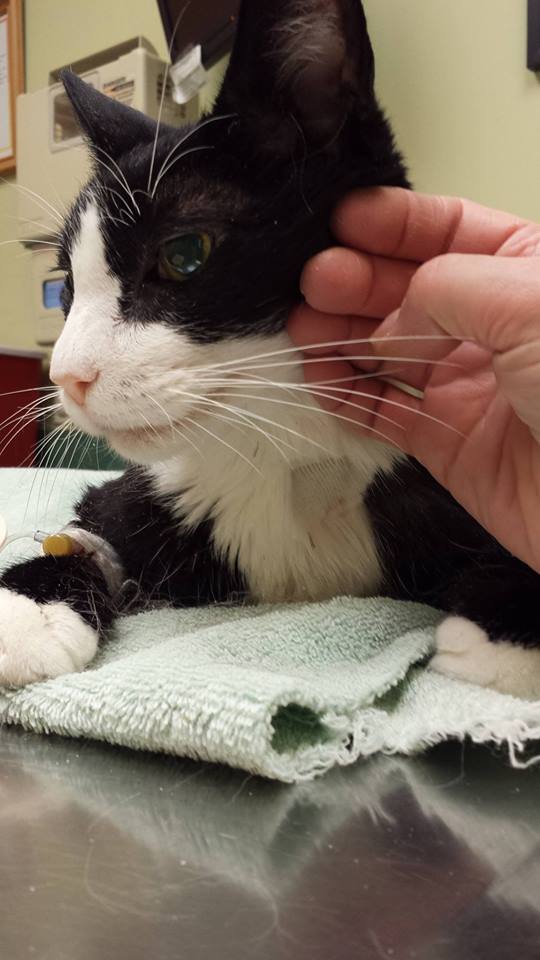By Laurie Goldstein, September 2015
 This is Part 1 of a three part series. (You can find Part 2 here and Part 3 here.)
This is Part 1 of a three part series. (You can find Part 2 here and Part 3 here.)
Please note: This series of articles was written with the needs of kitties with inflammatory bowel disease (IBD) or GI upset in mind. Cats with hyperthyroid or renal insufficiency (chronic kidney disease) can experience actual acid over-production that requires management with antacids; with this use, antacids are treating a by-product of a disease requiring management. With IBD or GI upset of unknown origin, using antacids for nausea or problems with stomach acid pukes is simply masking a symptom rather than treating the problem. Many vets view IBD as a disease that requires symptom management – but, while IBD cannot be cured, using a minimally processed diet, addressing gut dysbiosis (with probiotics, often no antibiotics needed), and by employing anti-inflammatory regimens (often including plant-based digestive enzymes), intestines and other organs impacted by inflammation can heal.
One of the most common health-related medicinal recommendations I see for cats experiencing gastrointestinal issues such as nausea, inappetence, and “overnight bile pukes” is Pepcid a/c (famotidine). And why not? It is perceived to be very safe, many vets recommend it, and antacids generally are easy to obtain all around the world. Call the vet first! They’ll probably say it’s OK to give it a try, and it often does (seem to) help. This is because acid suppression can address the symptoms and our uncomfortable kitties feel better and begin to eat or stop throwing up. Sometimes just stopping the cycle of nausea and inappetence for a couple of days is enough to turn the tide when your cat is feeling poorly. Short-term, occasional or intermittent use of antacids is not the issue.
Long-term use is.

So what are the problems?
Because we are led to believe they are completely safe, many cats are given antacids frequently, regularly, and have been on antacids long term to soothe upset tummies. And we may unintentionally and unknowingly be contributing to our kitties’ illness.
How are antacids making some cats sick?
The gastrointestinal tract is technically outside of the body. It is a giant hole, a passageway that snakes from mouth to anus filled with barriers to prevent unintentional movement from “outside” to “inside.” It is segmented with a system of valves to prevent “backflow” and isolate contents of one section from another until an appropriate time. Its purpose is not only to process nutrients we ingest, but to prevent infection from bacteria, viruses, parasites, and all the many toxins to which we are exposed. By its very nature, the GI system must account for the bulk of our immune system defense. Estimates of that percentage range from 70% to 80%: either way, the health of the GI tract and maintaining those barriers in proper condition is absolutely critical to overall health. The low pH of stomach acid and the low average pH of the stomach contents is one of the very first lines of that defense system.
Problem 1: Taking medications that constantly neutralize or block stomach acid production interfere with the body’s normal immune defenses.
The higher-than-normal pH created by the antacids is associated with
- C difficile infection
- bacterial overgrowth
- small intestinal bacterial overgrowth (SIBO), and
- bile acid deconjugation, a common (and often undiagnosed) cause of chronic diarrhea and fat malabsorption.
Problem 2: Antacids interfere with nutrient absorption.
 Have you ever prepared bone broth? Add a dash of apple cider vinegar (which is 5% – 7% acetic acid), and your broth softens the bones faster. Same principle here: stomach acid is needed to prepare vitamins and minerals for absorption, and has a critical role in B12 metabolism. With acid suppression, the pH of the stomach increases and the absorption of nutrients becomes impaired due to what is basically improper preparation. Decades of research show that low stomach acid (whether natural or induced by medication) reduces absorption of:
Have you ever prepared bone broth? Add a dash of apple cider vinegar (which is 5% – 7% acetic acid), and your broth softens the bones faster. Same principle here: stomach acid is needed to prepare vitamins and minerals for absorption, and has a critical role in B12 metabolism. With acid suppression, the pH of the stomach increases and the absorption of nutrients becomes impaired due to what is basically improper preparation. Decades of research show that low stomach acid (whether natural or induced by medication) reduces absorption of:
Problem 3: Motility and muscle tone.
The higher pH of the stomach artificially created by antacids results in delayed gastric emptying times (gastroparesis). This can cause
- Further increased stomach pH
- upper abdominal pain
- loss of appetite
- changes in blood sugar levels
- feeling full after eating only a little bit.
It has also been demonstrated that the cascade of chemical impacts from the higher-than-normal gastric pH can cause an abnormally relaxed ileocecal valve, leading to translocation of bacteria from the large intestine into the small intestine, which enables SIBO (see above).
Problem 4: Chronic Kidney Disease (CKD)/Chronic Renal Failure (CRF) and aging kitty antacid toxicity.
Antacids can become toxic if not used at reduced levels and/or reduced intervals in cats with kidney disease or in kidney failure due to slower renal clearance and longer drug half-life. The same is true in older cats due to altered physiology (water/fat/muscle mass changes due to age) that results in higher blood plasma concentrations. In fact, the manufacturers of antacids specifically recommend lower doses for humans with impaired renal function – yet as in people, these cautions are often overlooked in caring for our cats.
 Other Antacids
Other Antacids
There are two primary classes of acid suppressing medications:
- H2 Blockers (H2 antagonists): Pepcid a/c (famotidine); Zantac (ranitidine); Tagamet (cimetidine)
- Proton Pump Inhibitors (PPIs): Prilosec (omeprazole), Nexium (esomeprazole), Protonix (pantoprazole), and Prevacid (lansoprazole).
The H2 blockers like Pepcid are not the worst offenders when it comes to acid suppression, and all of the H2 blockers are available over-the-counter (at pharmacies without a prescription). Although the risks are generally the same for both classes of acid suppressants (and the risk of toxicity the same for kidney disease or renal failure), the probability of experiencing these unhealthy and unwanted side-effects are greater with the proton pump inhibitors like Prilosec (omeprazole) (see references).
PPIs inhibit acid secretion more effectively than H2 blockers which is why they are carry a higher risk of any or all of these associated problems. Omeprazole (Prilosec) is the only one of the PPIs sold at pharmacies without a prescription, and dosages for cats can (unfortunately) easily be found online.
These studies are in humans – why does this matter to my cat?
The basic chemical and neurological signaling mechanisms in the gastrointestinal tract are similar in cats and humans. This is why antacids designed for humans work to suppress stomach acid in cats and why we use them in the first place. Although there are no studies of the impact of acid suppressants in cats, the naturally low gastric pH is potentially more important for our obligate carnivores – especially if fed a fresh, species-appropriate food:
- Gastric pH acts as an ecological filter, preventing harmful bacterial infection and protecting the healthy balance of bacteria needed to support nutrient metabolism and overall health.
- Gastric pH impacts motility, and normal intestinal motility is a major defense mechanism against attachment of pathogenic bacteria in the small intestine.
- Low gastric pH is essential for cleaving B12 from the amino acids in meat;
- The low gastric pH is needed to properly metabolize minerals (let alone derive those minerals from bone).
This why we need to approach Pepcid a/c (famotidine), Zantac (ranitidine) and PPIs like Prilosec (omeprazole) with caution. There is a place for these drugs in the short term care of cats in gastric distress, no doubt. But ultimately the solution is to understand and cure or mitigate the underlying problem, rather than continue to mask it with a remedy that might be making your cat sicker in the long term.
I know – those of you who have cats with kidney disease are saying, “But there is no cure.” In Part 2, we share research that indicates most cats with kidney disease (unlike dogs and humans with CKD or CRF) suffer a nausea that is related to uremic toxins, not excess gastric acid, and is best treated centrally, not with antacids.
If my cat hasn’t been diagnosed with GERD, what are my treatment options? In Part 2 we discuss using diet as an alternative to antacid medications for managing kitty’s nausea and vomiting.
References
Ahn JS et al 2013. Acid suppressive drugs and gastric cancer: a meta-analysis of observational studies, World J Gastroenterol Apr 28:19(16):2560-8 (2013).
Beasley et al 2015. The Evolution of Stomach Acidity and Its Relevance to the Human Microbiome, PLoS ONE 10(7): e0134116. doi:10.1371/journal.pone.0134116 (2015).
Carter D et al 2013. Prevalence and predictive factors for gastrointestinal pathology in young men evaluated for iron deficiency anemia, May: 58(5):1299-305 (2013).
Cheungpastiporn W et al 2015. Proton pump inhibitors linked to hypomagnesemia: a system review and meta-analysis of observational studies, Aug: 37(7):1237-41 (2015).
Dukowicz AC et al 2007. Small Intestinal Bacterial Overgrowth: A comprehensive review, Gastroenterol Hepatol (NY), Feb: 3(2):112-122 (2007).
FDA News Release May 25, 2010. FDA: Possible Fracture Risk with High Dose, Long-term Use of Proton Pump Inhibitors
Gallieni M & Cancarini G 2015. Drugs in the Elderly with Chronic Kidney Disease, Nephrol Dial Transplant, 30(3):342-344 (2015).
Islam RS and DiBaise JK 2012. Bile Acids: Nutrition Issues in Gastroenterology, Series #110, Practical Gastroenterology (October 2012).
Jameson R et al 2013. Proton Pump Inhibitor and Histamine 2 Receptor Antagonist Use and Vitamin B12 Deficiency, JAMA 310(22):2435-2442 (2013).
Lo WK and Chan WW 2013. Proton pump inhibitor use and the risk of small intestinal bacterial overgrowth: a meta-analysis, Clin Gastroenterol Hepatol May: 11(5):483-90 (2013).
Lombardo L 2010. Increased incidence of small intestinal bacterial overgrowth during proton pump inhibitor therapy, Clin Gastroenterol Hepatol Jun: 8(6): 504-8 (2010).
Manlucu et al 2005. Dose-reducing H2 receptor antagonists in the presence of low glomerular filtration rate: a systematic review of the evidence, Nephrol Dial Transplant, Nov:20(11):2376-2384 (2005).
Mora JR and von Andrian UH 2009. Role of retinoic acid in the imprinting of gut-homing IgA-secreting cells, Seminars in Immunology 21:28-35 (2009).
Marcuard SP et al 1994. Omeprazole Therapy Causes Malabsorption of Cyanocobalamin (Vitamin B12), Annals of Internal Medicine, Vol 120, No. 3 (Feb 1994).
Parkman HP et al 1998. Effect of gastric acid suppressants on human gastric motility, Gut 42:243-250 (1998).
PennState-Hershey, Milton S. Hershey Medical Center. Ulcer Medications – histamine H2 antagonists.
Roulet L et al 2012. Adverse effects of proton pump inhibitors: should we worry about long term exposure? Rev Med Interne Aug: 33(8):439-45 (2012).
Russell RM et al 1988. Effect of antacid and H2 receptor antagonists on the intestinal absorption of folic acid, J Lab Clin Med Oct: 112(4):458-63 (1988).
Shindo K & Fukumura M 1995. Effect of H2-receptor antagonists on bile acid metabolism, J Investig Med, Apr: 43(2)170-7 (1995).
Suchodolski, JS 2011. Companion Animals Symposium: Microbes and gastrointestinal health of dogs and cats, J Anim Sci 89:1520-1530 (2011).
Thorens J et al 1996. Bacterial overgrowth during treatment with omeprazole compared with cimetidine: a prospective randomized double blind study, Gut 39:54-59 (1996).
Tleyjeh IM et al 2013. The Association between Histamine 2 Receptor Antagonist Use and Clostridium difficile Infection: A Systematic Review and Meta-analysis. PLoS ONE, 2013; 8 (3): e56498.
Vadokas B et al 1997. Effects of gastrin-releasing peptide (GRP) on the mechanical activity of the human ileocaecal region in vitro, Neurogastroenterology & Motility Dec: 9(4):265-270 (1997).
Vighi et al 2008. Allergy and the gastrointestinal system, Clin Exp Immunol 153 (Suppl 1): 3-6 (2008 Sep).
Wilhelm SM et al 2013. Perils and pitfalls of long-term effects of proton pump inhibitors, Expert Rev Clin Pharmacol, Jul: 6(4):443-51 (2013).
If you enjoyed this article or found it informative, please “Like” it, “Share” it, “Tweet” it, or zip me an email and let me know about it! And don’t forget to check out our FB page, join the discussions in our FB group and follow us on Twitter!
Created 09/27/15

